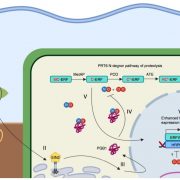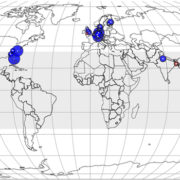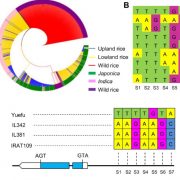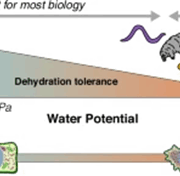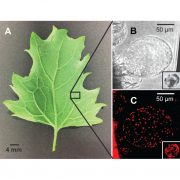How Does a Plant Tolerate Prolonged Darkness?
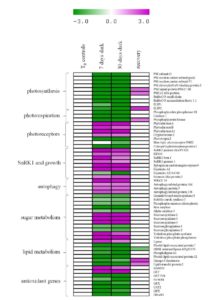 The exposure of plants to prolonged darkness leads to the exhaustion of starch reserves and carbon and energy starvation. In such cases, plants must use alternative nutrient and energy sources to survive. Autophagy is an important mechanism that breaks down proteins and lipids and thereby provides the cell with alternative carbon, nitrogen, and energy during starvation. Haberlea rhodopensis is a desiccation-tolerant native of the Balkans and a member of the Gesneriaceae. In contrast to other species, the integrity and activity of the photosynthetic apparatus of this resurrection plant is preserved for months after their placement in darkness and during this time, no visible senescence symptoms can be observed. Such tolerance to prolonged darkness is rarely seen in angiosperms and the molecular mechanisms behind this phenomenon have not been studied. A transcriptomic analysis by Durgud et al. (10.1104/pp.18.00055) reveals that darkness regulates several transcription factor genes in his species. Stress- and autophagy-related transcription factors, for example, are upregulated, while chloroplast- and flowering-related transcription factors are repressed. PHYTOCHROME INTERACTING FACTOR 4 (PIF4), a negative regulator of photomorphogenesis and promoter of senescence, is also downregulated. In response to darkness, most photosynthesis- and photorespiratory-related genes are strongly downregulated, while genes related to autophagy are upregulated. Most of the genes associated with chlorophyll catabolism, which are induced by darkness in more typical dark-senescing species, were either unregulated or repressed. Metabolite profiling revealed increases in the levels of many amino acids in darkness, suggesting increased protein degradation. In darkness, levels of the chloroplast lipid species decreased, while those of storage triacylglycerols increased, suggesting degradation of chloroplast membrane lipids and their conversion to triacylglycerols for use as an energy and carbon source during exposure to prolonged darkness in this species.
The exposure of plants to prolonged darkness leads to the exhaustion of starch reserves and carbon and energy starvation. In such cases, plants must use alternative nutrient and energy sources to survive. Autophagy is an important mechanism that breaks down proteins and lipids and thereby provides the cell with alternative carbon, nitrogen, and energy during starvation. Haberlea rhodopensis is a desiccation-tolerant native of the Balkans and a member of the Gesneriaceae. In contrast to other species, the integrity and activity of the photosynthetic apparatus of this resurrection plant is preserved for months after their placement in darkness and during this time, no visible senescence symptoms can be observed. Such tolerance to prolonged darkness is rarely seen in angiosperms and the molecular mechanisms behind this phenomenon have not been studied. A transcriptomic analysis by Durgud et al. (10.1104/pp.18.00055) reveals that darkness regulates several transcription factor genes in his species. Stress- and autophagy-related transcription factors, for example, are upregulated, while chloroplast- and flowering-related transcription factors are repressed. PHYTOCHROME INTERACTING FACTOR 4 (PIF4), a negative regulator of photomorphogenesis and promoter of senescence, is also downregulated. In response to darkness, most photosynthesis- and photorespiratory-related genes are strongly downregulated, while genes related to autophagy are upregulated. Most of the genes associated with chlorophyll catabolism, which are induced by darkness in more typical dark-senescing species, were either unregulated or repressed. Metabolite profiling revealed increases in the levels of many amino acids in darkness, suggesting increased protein degradation. In darkness, levels of the chloroplast lipid species decreased, while those of storage triacylglycerols increased, suggesting degradation of chloroplast membrane lipids and their conversion to triacylglycerols for use as an energy and carbon source during exposure to prolonged darkness in this species.


